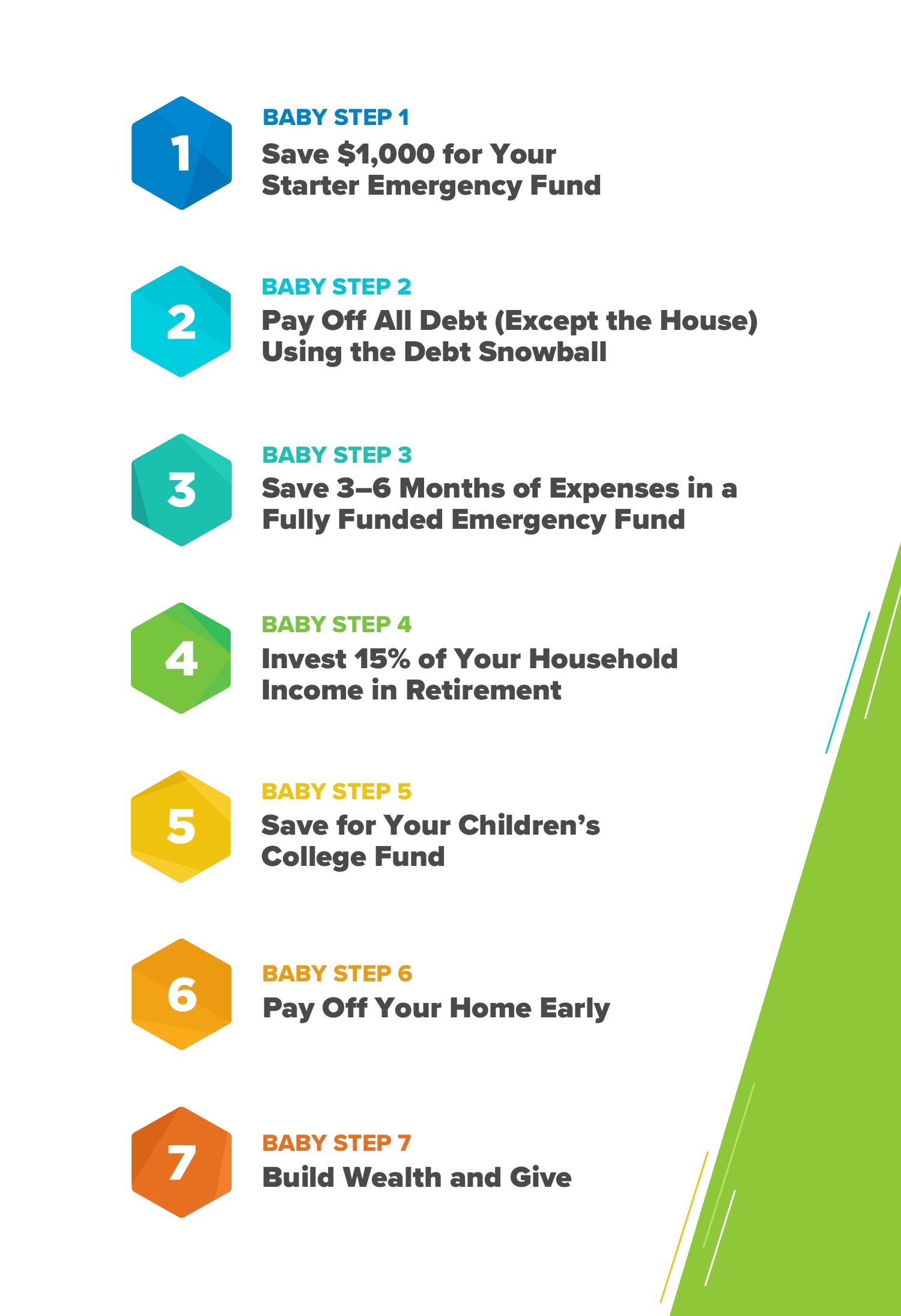Step one: Never spend money again. Boom. Done.
Just kidding!
Lucky for you, that’s not the direction of this article. We can show you how to get ahead with your money in just 7 Baby Steps. So, grab an extra pair of socks, friends, because we’re about to knock. Yours. Off.
What Are Dave Ramsey’s Baby Steps?
The 7 Baby Steps are the proven plan to paying off debt, saving money, and building wealth. They’ve proven themselves time and again as steps that work.
If you want to do better, be better, and live better with money, you’re probably looking at what seems to be a mountain of work to get you there. How do you climb a mountain? How do you reach the top of those Everest dreams? One (baby) step at a time.

Baby Step 1: Save $1,000 for Your Starter Emergency Fund
Only 36% of Americans say they can pay cash for a $400 emergency.1That means 64% of them are borrowing, selling or going into debt when life happens. And it does. Your car’s catalytic converter breaks. Your kid busts his chin and needs stiches from the ER. Your washing machine won’t live to spin again. That’s life. Be ready with cash.
How: Start saving more money and spending less. You can save $1,000 quicker than you think—really. It just takes a little focus and some hard work. Try selling stuff, clipping coupons, saying no to extra expenses, planning your meals, eating out less, using or selling old gift cards, and downloading money-saving apps. The ways to earn or save $1,000 are nearly endless. Pick a few and get down to saving up.
Baby Step 2: Pay Off All Debt (Except the House) Using the Debt Snowball
Debt’s good for one thing and one thing only: holding you back. But you don’t want to be held back. You want to thrive—and the thriving starts here. You’ve got $1,000 saved up so you can use that money instead of going deeper into debt when an emergency hits. Now it’s time to attack debt with a vengeance using the debt snowball method. Pay off one debt at a time from smallest to largest, gaining momentum until you’re debt-free.
Budget every dollar, every month. Get started with EveryDollar!
How: Remember those money-saving tricks from Baby Step 1? Use them and put all that extra cash toward defeating debt. In fact, turn up the heat and see how thrifty you can get while you’re on this step. It’s not forever, and when you’re living free from debt, you’ll look back and see the effort was totally worth it.
Baby Step 3: Save 3–6 Months of Expenses in a Fully Funded Emergency Fund
The debt is gone. Bye bye, debt. Talk to you never. Now, you’re going to beef up that emergency savings fund so it’s strong enough to stand up against bigger problems, like job loss. Figure out how much money you’d need to live for three to six months if your regular income went away. (If you’re a one-income household, aim for six months of expenses. Two-income households can go for three.) Save up that amount, and store it in a high-interest savings or money market account with check-writing privileges so you can get to it if you need to.
How: You’re already in a pattern of saving. You clip and tap coupons all the time. You downloaded so many money-saving apps, you have to delete photos of your pup weekly for storage. You started brewing your own coffee at home—and even like it better. (Gasp.) So, keep those money-saving habits going and build your savings into a fully funded emergency fund.
Baby Step 4: Invest 15% of Your Household Income in Retirement
Retirement can seem like tomorrow’s problem. But that kind of thinking will leave you working for the rest of your life. In Baby Step 4, it’s time to start preparing for your future by investing 15% of your gross household income into retirement accounts.
How: Here’s the simple breakdown. When you start this step, first look into your employer’s 401(k), if you have one, and invest up to the match. Then open a Roth IRA and max out how much you can contribute to this fund. If you hit the max and still haven’t reached 15% of your income, go back to your 401(k) and contribute the rest there!
Note: If your employer offers a Roth 401(k) and you like the investment options, you can invest your whole 15% there.
Because it’s so confusing, we suggest you don’t make money moves like that without finding a reputable investment pro. These people enjoy investment lingo but know how to talk to you in a way you can understand. They’ll listen to your preferences and help guide you on your investment journey as you set yourself up to save for the retirement of your dreams.
Baby Step 5: Save for Your Children’s College Fund
No kids? Kids fully grown and out of the house? You can skip this step and move on to the next. Otherwise, it’s time to start researching and stashing away cash for your kids to further their education. One important note: You’ll be working on Baby Steps 4, 5 and 6 at the same time, but you’ll start them in this order.
Why wait to worry about the kids until after you start saving for retirement? One reason is that your kids may or may not go to college—but you will definitely retire. Also, there’s no reason to send them to overwhelmingly expensive universities that’ll leave you unable to pay your bills when you quit working. Putting retirement first is not selfish. It’s wise.
How: First, look at opening an Educational Savings Account (ESA) or 529 college savings fund.
Next, remember this: Going to college without going into debt is possible. There are tons of grants and scholarship options out there. And your kids should always consider in-state and community college options and—by golly—working throughout school to pay for tuition and fees. Using this Baby Step and all those tactics, your kids can get a diploma without debt.
Baby Step 6: Pay Off Your Home Early
The average American has a monthly mortgage budget line of almost $1,600.2 What if that disappeared, not because of magic, but because you paid off your house—in full. You’ve stopped renting from the lending company, and that home sweet home is yours all yours. It’s nearly impossible to imagine, really. But it’s possible to achieve, really.
How: First, look into refinancing.Do you have a 30-year or adjustable-rate mortgage? Switch to a 15-year. Are rates better? Has your house gone up in value? If so, refinancing could be the game changer for this Baby Step. Another tip is to make one extra house payment per quarter. You’ll pay off your mortgage 11 years earlier and save around $65,000 in interest alone!
Baby Step 7: Build Wealth and Give
Now it’s time to grow your wealth beyond your wildest dreams—though they won’t seem as wild anymore because you’re going to reach them. And when you do, you’ll not only be living like no one else, you’ll be in a position to give like no one else. Your money won’t be tied up in debt or mortgages or worry. It’ll be free to share with your favorite charities or your church. You can be in a position of easy generosity. What a beautiful feeling.
How: Remember your 401(k) and Roth IRA? Max. Them. Out. As your retirement fund grows, use your remaining wealth to have some fun and help others. Oh, and try not to break our EveryDollar app with all those zeros. Please and thank you.
Why Should I Follow the Baby Steps in This Order?
1. To focus on one goal at a time.
As you’re looking to all the money goals in your future, it’s overwhelming—so much to do, so little time. But there is time, and there is a proven path to break up those goals into manageable and achievable pieces that will set you up for success. Because remember: How do you climb a mountain? One (baby) step at a time.
2. To avoid going into debt again.
Notice the first three Baby Steps are all about avoiding and paying off debt. They launch you to a debt-free lifestyle like a success rocket. The first $1,000 emergency fund is starter fuel, keeping you going, and still feeling secure, while you eliminate your debt. And that fully funded emergency fund you saved up on Baby Step 3 means you always have cash ready, so you don’t even think about running back to your borrowing ways. 3 . . . 2 . . . 1 . . . Blast off to being set against debt.
3. To keep your priorities in check.
The moment often feels like the most important thing. That thinking can make us pay far too much for our kid’s unicorn-themed birthday party—complete with a four-tiered cake topped with a fondant dancing unicorn and edible glitter rainbows. Teaching your kids the value of saving and dumping debt is a better gift than one you wrap with a giant sparkly bow, no matter how good all those party pics will look on Instagram.
In fact, it’s a better gift for yourself than those fancy gold-trimmed headphones that remind you to do things like take out the trash. These Baby Steps help you set up and focus on a true better-life standard, one that goes beyond social media and into what really matters.
4. To watch and celebrate your progress.
When you reach the finish line of one of those Baby Steps, it’s time to celebrate. Seriously. Throw yourself a (low-cost) party! Invite friends. Create a special celebratory family dance. It won’t take the world by storm like the “Macarena,” but it will take your life by storm.
When you walk one Baby Step at a time, you can observe your improvements, applaud your achievements, and know what’s next. Because after one Baby Step comes the next.
Step. Step. Step. Save. Succeed.
What Should I Do to Get Started With the Baby Steps?
Budget.
Aren’t you glad the answer is simple?
Start with a budget. Today. This is Baby Step 0, and it’s the step you never stop. A budget shows you where your money is actually going, so you can start telling it where you want it to go. A budget sets up a natural accountability with yourself. A budget creates goals.
Knowledge. Empowerment. Accountability. Goals. These are all so important if you’re going to get where you want to be in life and with your money. And they all come when you budget. And we’ve got a free tool to help you do just that. Whoop whoop! That’s right—the EveryDollar app is just the thing you need no matter the step you’re starting on. From beginning to end, you’re going to need a budget.
If you’re already budgeting, it’s time to keep moving through the Baby Steps. Want to know a secret? You don’t have to do it alone. Check out Financial Peace University(only available through Ramsey+). It’s a nine-lesson class that will show you how to win with money . . . step-by-step. Start your free trial here.
This article is a repost from https://www.ramseysolutions.com/budgeting/how-to-win-with-money-in-7-easy-baby-steps
Photo by Karolina Grabowska: https://www.pexels.com/photo/crop-man-getting-dollars-from-wallet-4386433/

